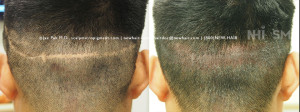I have a question about DHT that just occurred to me.
DHT is, at this time, considered to be the main cause of male-pattern baldness. If this is really the case, could you please explain the following …
DHT levels are highest in early adulthood and gradually decline with age, yet most men do not suffer from hair loss until later in life (when their DHT levels are much lower).
If DHT is really the culprit of hair loss, why does most hair loss in men seem to occur about the same time that DHT levels are declining and stabilizing? It really makes no sense to me.

Your statement is false in that GENETICS is the main cause of male-pattern baldness (MPB) otherwise referred to as genetic balding or androgenic alopecia (AGA) and when you have the balding gene, it is the hormone dihydrotestosterone (DHT) that causes the hair loss process when the gene for hair loss is present. There may be other undiscovered hormones and mechanisms but DHT is the one hormone that we know about at this time.
In addition, if you have the genes for balding, most men lose most of their hair in your 20s and early 30s. Of course there are exceptions to the rule, but chances are if you ask a bald man (e.g. Class 7 pattern of balding) when he started to lose his hair, he would likely say in his late teenage years or his early 20s.
DHT is a byproduct of testosterone metabolism and it is true that young men have more testosterone and DHT than older men but testosterone or DHT levels don’t cause the balding process… GENETIC predisposition does. Perhaps many people are confused on this fact because it’s sort of like a chicken or the egg dilemma. Does DHT trigger the balding, or does genes trigger the balding? (Answer=genes) Men start balding process in their 20’s and 30’s mainly because that is when their genetic destiny is triggered by DHT. If a man did not have testicles, he would not make DHT and therefore, he would not bald even with the gene for balding.
It is thought that about 50% of men have the genes for some degree of male pattern balding. About 7% of the men have total Norwood 7 balding. The life of a hair is dependent on the genetic timing of each hair’s life and in the pattern of genetic balding. In some patterns, the frontal hairs my die first (in men), in other like me (Dr. Rassman) the hairs in my crown died and my frontal hairline was never impacted (because that was the results of the genes I inherited). The life of a hair follicle relates to how many cycles it has (probably programmed genetically) and the death of that hair follicle occurs when the number of hair cycles is reached. So, for example, if a hair located in the front of the hairline has a 3 year hair cycle and the genetics have programmed 10 hair cycles, then that frontal hair will die when that person reaches 30 years of age. This is impacted by the presence of DHT in genetic “death” of a hair follicle (apoptosis). Without DHT (which can be partially blocked by finasteride), the number of hair cycles may actually increase beyond its programmed death. This is probably a simplistic way of explaining the number of hair cycle that exist for all hairs on your head, but the main point is that GENETICS determines hair loss and DHT is the precipitating cause when the number of genetically programmed hair cycles are reached. Because it is the genes that cause hair loss, the presence of DHT impacts only those genes when the per-programmed hair cycle is reached for each hair.
For men without a genetic inheritance of male pattern baldness, it does not matter how much DHT you have (or don’t have), balding will not occur. The classic case that exemplifies this is a case of twins, where one of the male twins was castrated in his youth for mental illness (a situation that shamefully occurred in the early part of the 20th century). The story goes that the non-castrated twin (who was bald) came to see his brother in the mental institution and saw his ‘hairy’ counterpart. The doctor was amazed and performed an experiment on the hairy, castrated twin. He was given testosterone (which was turned into DHT by the hairy twin’s body). Guess what? He lost his hair just like his bald brother. This final story may spawn new questions on why we don’t take medication that block DHT 100% or take stronger DHT blocking medications such as avodart (Proscar) to treat male pattern balding. It is mainly because once the genetic switch is turned on, you cannot stop it and blocking DHT 100% might slow the process down and may give you unwanted adverse side effects. I doubt anyone would volunteer to be castrated. The only exceptions are transgender males going through hormone therapy and sex change operation/ castration.







